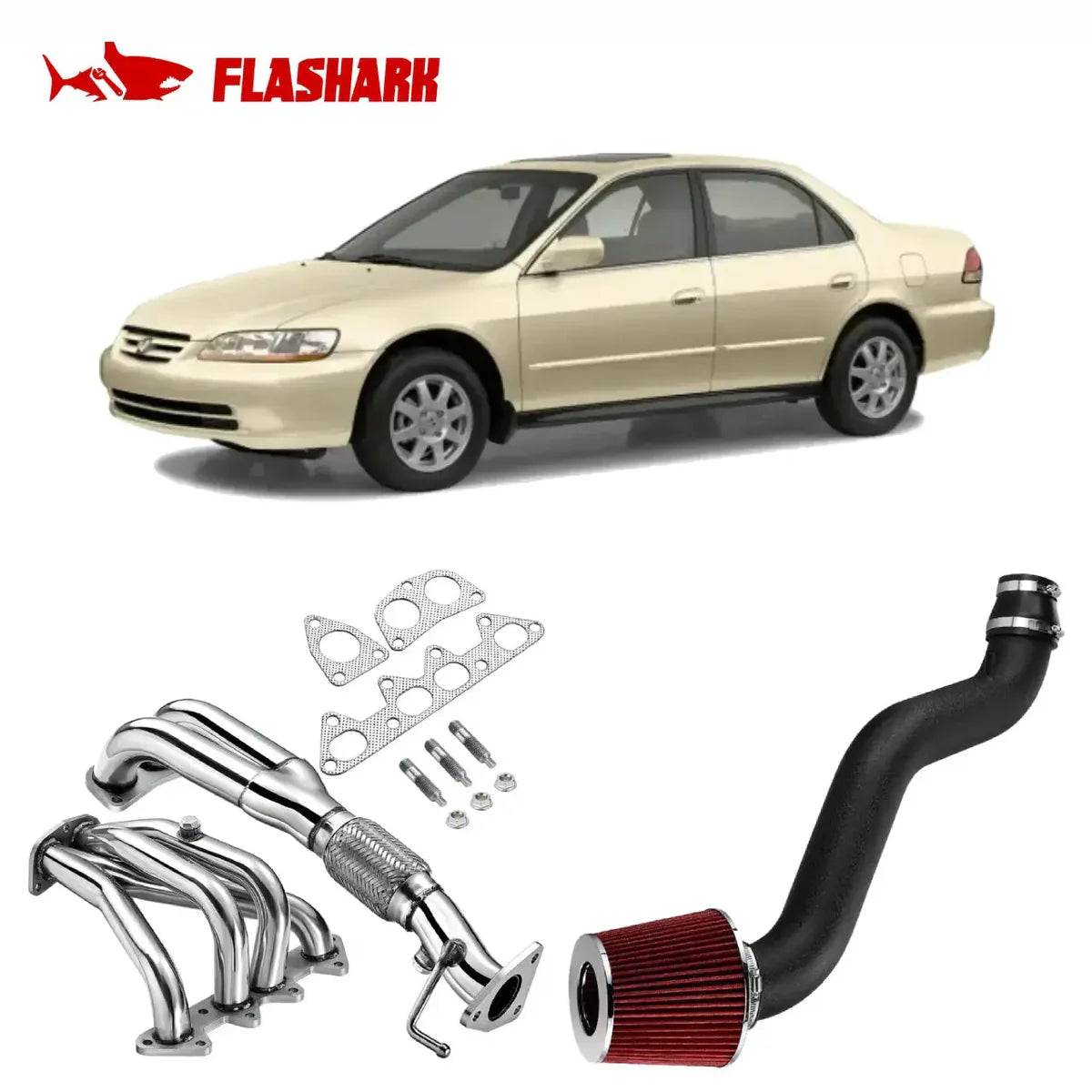Our products are designed based on OEM specifications and are suitable for unmodified vehicles. If your vehicle has been modified, compatibility or installation cannot be guaranteed. We recommend confirming your vehicle's setup or consulting our customer service team before purchase. We're here to help!
Description
Flashark Exhaust Header for 1998-2002 Honda Accord EX/ LX CG1/ CG2 4Cyl 4-2-1 2.3L F23A1/F23A4/ F23A5
Enhance your 1998-2002 Honda Accord with Flashark's high-performance Honda Accord headers. Specifically designed for the 2.3L F23A1/F23A4/F23A5 engine, these stainless steel 4-2-1 headers optimize exhaust flow, boosting horsepower, torque, and throttle response. Perfect for improving both engine performance and sound, these headers are a direct bolt-on upgrade for your Accord, delivering noticeable gains in both power and efficiency.
Fitment:
- 1998-2002 Honda Accord l4 EX/ LX CG1/ CG2 F23A1/F23A4/F23A5
Specifications:
Brand Name: FLASHARK
Certificate: ISO9001:2000
Application: Automobile Exhaust Header
Material: Stainless Steel
Surface: Mirror Polish
Placement on Vehicle: Front
O2 Sensor Bung Included: Yes
Manufacturer Warranty: Permanent Warranty
Header Inlet: 1.75"
Outlet Size (IN): 2.00"
Mounting Style:3 Bolt
Design Model: 4-2-1 Exhaust System
Advantages of the 4-2-1 Design
-
Improved Low to Mid-Range Torque: The Honda Accord headers with a 4-2-1 design optimize exhaust flow, particularly in the low to mid-range RPMs, significantly enhancing torque output. Compared to other designs, such as the 4-1, the 4-2-1 configuration provides better engine response in these RPM ranges, making it an ideal upgrade for your Honda Accord.
-
Reduced Exhaust Interference Between Cylinders: The 4-2-1 design in these Honda Accord headers effectively minimizes exhaust interference between cylinders, leading to improved exhaust efficiency and overall engine performance, ensuring smoother power delivery and better overall responsiveness for your Honda Accord.

Features
- Improves engine efficiency and throttle response
- Increases horsepower and torque (8–20 HP gain)
- Enhances exhaust flow and performance sound
- Direct bolt-on, no modification needed
- May improve fuel efficiency (~0.5 mpg)
Delivery:
Free Shipping
Shipping Time: Estimated in 3-5 Working Days
Warranty:
Duration of Warranty: Permanent Warranty.

Header Upgrade vs. Stock Exhaust Manifold (1998–2002 Honda Accord 2.3L F23A)
For the 1998–2002 Honda Accord 2.3L (F23A1/F23A4/F23A5), upgrading from the factory cast-iron manifold to a performance header provides meaningful improvements in both driving feel and long-term efficiency.
- OE-Level Structural Strength: Designed to resist deformation and cracking, helping prevent exhaust leaks and ensuring consistent performance.
- Reduced Backpressure: The OEM manifold restricts exhaust flow, while headers separate exhaust pulses for smoother, freer breathing.
- Quicker Throttle Response: Improved scavenging lets the engine react faster, making acceleration more immediate and enjoyable.
- Stronger Low–Mid RPM Torque: Ideal for daily driving—better takeoff power, smoother climbs, and more confident passing.
- Cleaner, Cooler Combustion: Efficient exhaust flow reduces heat and stress on engine components, supporting long-term reliability.
-
Sportier Exhaust Tone: A deeper, more refined sound compared to the muted factory setup.
Why Choose Flashark Exhaust Headers
Upgrade your 1998–2002 Honda Accord 2.3L with Flashark headers for instant power, stronger torque, and a sportier exhaust tone. Made from high-quality stainless steel with superior heat and oxidation resistance, these headers deliver long-lasting reliability while enhancing engine efficiency.
With direct bolt-on installation and OE-inspired structural strength, Flashark headers are the smart, performance-driven choice for drivers who want more power, better throttle response, and an exhilarating driving experience.

About the 1998–2002 Honda Accord EX/LX
The 1998–2002 Honda Accord EX and LX, part of the sixth generation, are well-known for their reliability, comfort, and balanced performance. These models commonly feature 2.3L inline-4 engines: F23A1, F23A4, and F23A5, offering smooth operation and long-term durability. The 2000 Accord is particularly notable for safety improvements, including dual-stage passenger airbags and enhanced side-impact protection, making it a standout choice among these years. With a solid combination of efficiency, comfort, and performance potential, these Accords are a great platform for upgrades like high-performance headers and exhaust systems.
















